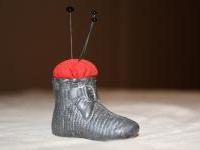“Woman is a bit of a slave in this country”
The Journals of Anne Langton, 1839.
Traditionally, a woman’s sphere was in the home, and the commonly accepted role for an adult woman was that of wife, mother and homemaker. The family was the fundamental building block of society and women were at the centre. By the 1870s, however, technical innovations and industrial growth inevitably and radically altered the structure of the home. Mass production removed certain household tasks from the home to the factory, while labour-saving devices and ready-made food and clothing meant that domestic tasks consumed less time.
Despite the new kitchen tools and the eventual advent of electrical appliances, to run an efficient household and ensure good health, food and clothing, a woman was required to work long and often difficult and strenuous hours. Indeed, it can be said with confidence that women worked longer hours than men in a day.
Critics of the social changes believed that any attempt by women to lead an independent life was an attack upon the family and therefore upon the stability of society. Women, however, expressed their belief that they had to prepare their families for the trials of the contemporary world. The concept of “maternal feminism” allowed women to widen their influence by taking out into society the very qualities which made them so valuable within the family.
 Through their role of record keepers, caretakers and caregivers within the family, women were able to become secretaries, clerks, librarians, teachers, journalists and nurses. In the 1871 Census Record for Missisquoi County, 68 women were listed as wage earners. The majority of these women were in “Domestic Service.” In the 1891 census, 240 women were working out of the home and, although the majority were still working as domestic servants, women were also listed as teachers, nurses, store clerks, and book keepers. Lucy Staniland was a florist, Mrs. E. S. Tracey, a postmistress, Cora Cook, a telegraph operator, Charlotte and Elizabeth Derrick, agriculturists, Elizabeth Steel, a cheese maker, and Laura Swells, a carpenter -- these last two professions usually being reserved for men.
Through their role of record keepers, caretakers and caregivers within the family, women were able to become secretaries, clerks, librarians, teachers, journalists and nurses. In the 1871 Census Record for Missisquoi County, 68 women were listed as wage earners. The majority of these women were in “Domestic Service.” In the 1891 census, 240 women were working out of the home and, although the majority were still working as domestic servants, women were also listed as teachers, nurses, store clerks, and book keepers. Lucy Staniland was a florist, Mrs. E. S. Tracey, a postmistress, Cora Cook, a telegraph operator, Charlotte and Elizabeth Derrick, agriculturists, Elizabeth Steel, a cheese maker, and Laura Swells, a carpenter -- these last two professions usually being reserved for men.
Women left few records of their daily work routine, except in their handiwork. However, their contributions to the growth of families and the stability of communities must not go unrecognized. In addition to their domestic work and the responsibilities of motherhood, women were also volunteers in religious and social organizations, cared for extended families, and contributed to the family income through cottage industries such as butter and cheese making, sewing and weaving, or the selling of garden produce at local markets. The domestic tools and personal items in this on-line exhibit belonged to the hard-working women of Missisquoi County.

























